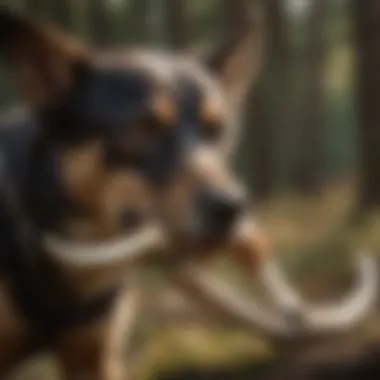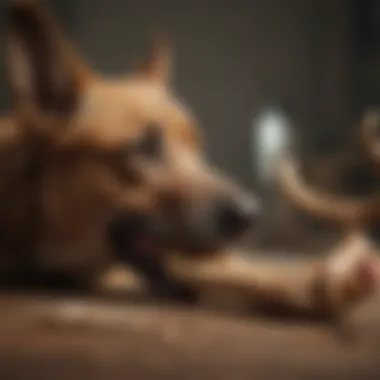Understanding Dogs Chewing on Antlers: A Comprehensive Overview


Intro
Dogs exhibit a variety of behaviors that can seem odd or perplexing to humans. One such behavior is chewing on antlers. This article aims to elucidate why dogs engage in this activity, focusing on the benefits and risks associated with it. By examining the nutritional implications, dental health advantages, and safety considerations, dog owners can make informed decisions about their pets' chewing habits. Understanding these factors is essential for both the well-being of pets and for responsible ownership.
Antler Overview
Antlers as a Chewing Option
Antlers are a popular choice among dog owners for several reasons. They are natural, long-lasting, and provide various nutritional benefits. Antlers are composed primarily of calcium and phosphorus, essential minerals for a dog's health. Furthermore, their density makes them an appealing alternative to softer chew options, which may not satisfy a dog's instinctual need to chew.
Nutritional Value
- Calcium: Promotes strong bones and teeth.
- Phosphorus: Works in tandem with calcium for nutrient absorption.
- Trace Minerals: Supports overall health.
The nutritional aspect of antlers makes them a favored choice among pet owners, but caution should be exercised to select quality products and monitor their dog's chewing behavior.
Benefits of Chewing on Antlers
Dental Health
Chewing on antlers can have a positive impact on a dog's dental health. The abrasive nature of antlers helps to remove plaque and tartar buildup, reducing the risk of dental diseases. Chewing also stimulates the gums, promoting better overall oral hygiene.
Behavioral Benefits
Chewing provides mental stimulation for dogs. It can alleviate boredom and reduce anxiety by offering an outlet for their energy. This can lead to a calmer dog overall.
Comparing Chew Options
When evaluating antlers against other chew products, it is crucial to consider safety and health aspects. For example, rawhide chews may present risks of choking or digestive issues, while antlers tend to be less risky if given in moderation.
Potential Risks of Antler Chewing
While antlers offer several benefits, there are potential risks to consider.
- Dental Damage: Hard antlers can potentially break a dog's teeth.
- Digestive Issues: If large pieces are swallowed, they can lead to blockages.
- Type of Antler: Not all antlers are suitable for every dog.
It is best practice for pet owners to supervise their dogs when chewing on antlers and to consult with a veterinarian if there are any concerns regarding their dog's chewing habits.
Selecting the Right Antlers
When choosing antler products, consider the following factors:
- Size: The antler should be appropriate for the dog's size and chewing strength.
- Type: Choose between deer, elk, or moose antlers, depending on availability and preference.
- Processing: Look for natural, untreated options to avoid chemicals and additives.
Always prioritize the safety, health, and enjoyment of your dog when selecting chews.
Finale
Understanding the reasons why dogs chew on antlers can empower pet owners. By recognizing both the advantages and possible risks, dog owners can make educated choices for their pets. Antlers can serve as a beneficial supplement to a dog's diet while also addressing behavioral needs. The key lies in moderation and awareness.
Prologue to Dogs and Chewing Behavior
Dogs have an intrinsic relationship with chewing. This behavior is more than a mere pastime; it serves essential purposes in their lives. Understanding the context and significance of a dog’s chewing habits can help pet owners make informed decisions about appropriate chew options, including antlers. This foundation sets the stage for exploring various aspects of dog chewing behavior, particularly regarding the different materials available.


The Natural Instinct to Chew
Chewing is a natural instinct rooted in canine behavior. From puppyhood, dogs start to explore the world through their mouths. This instinct plays a role in their development, aiding in teething and promoting oral health. As dogs mature, this behavior persists, influenced by both evolutionary traits and environmental factors. Chewing helps dogs relieve boredom, reduce anxiety, and even assert dominance in certain situations. Owners should recognize that providing appropriate chew items aligns with these instincts and can enhance their dogs' well-being.
Common Chewing Materials
When it comes to selecting chew items for dogs, there are a myriad of options available. Common materials include:
- Rawhide: Often used due to its affordability and availability, rawhide can be controversial because it may pose choking risks or digestive issues if not consumed properly.
- Rubber Chews: Durable and safe, these are popular among dog owners. These toys can withstand heavy chewing and often provide a fun challenge for dogs.
- Nylon Chews: Known for their long-lasting nature, nylon chews can also help to clean teeth, albeit they may cause some wear on the dog's dental health if excessively chewed.
- Wood and Antlers: These natural materials have gained popularity, particularly antlers, which dogs enjoy for their tough texture and nutritional content. Understanding the pros and cons of each material is crucial for ensuring safe and satisfying chewing experiences for dogs.
Exploring Antlers as a Chew Option
Understanding the choice of chew materials for dogs is important for various reasons. Antlers represent a natural and often more sustainable option compared to many other manufactured products. They not only serve as a source of entertainment for dogs but also offer nutritional benefits. This section will explore key elements such as the origin and composition of antlers, insight into different types of antler chews available on the market, and considerations that pet owners should take into account.
Origin and Composition of Antlers
Antlers are actually a unique phenomenon in the animal kingdom. They are made of a type of bone called osseous tissue and are primarily found in members of the Cervidae family, such as deer, elk, and moose. Unlike horns, which are permanent and grow continuously, antlers are shed and regrown annually. This natural cycle is essential for the animal's health and plays a role in mating rituals and territorial displays.
When considering antlers for dogs, it is essential to note their source. Antlers can be sourced from various species, with elk and deer being the most common. Antlers are dense and rich in nutrients, including calcium and phosphorus, which contribute to their appeal as a chew.
Understanding the composition of antlers can help dog owners make informed choices. The outer layer, known as the velvet, contains essential nutrients and is softer than the bare bone beneath. However, the inner core is much harder and can pose risks for some dogs. Therefore, awareness of an antler's specific part is crucial when selecting chew options.
Types of Antler Chews Available
There are several types of antler chews available in the market, each catering to different dog needs and preferences. Consider the following types:
- Whole Antlers: These are the complete, unaltered antlers, generally sourced from deer, elk, or moose. They can vary in size and hardness, catering to larger dog breeds that require tougher chews.
- Split Antlers: These are cut down the middle, exposing the marrow. This option usually attracts dogs due to its softer texture and richer taste. Split antlers typically provide more immediate satisfaction, especially for those who enjoy reaching for the tasty marrow inside.
- Antler Powder: Ground into a powder, this form is often mixed into dog food or treats. It delivers nutritional benefits without the risk associated with chewing hard materials.
- Antler Knuckles: These are smaller pieces of antler, suitable for dogs that are heavy chewers but may not need the size of a whole antler.
Choosing the right type of antler chew will depend on various factors. These factors include the dog's size, chewing habits, and specific health considerations.
"Antlers can be a natural solution that satisfies your dog's instinct to chew, while also providing essential nutrients."
Nutritional Aspects of Chewing Antlers
Understanding the nutritional aspects of antlers is essential for dog owners considering these chew options. Antlers, often viewed as a natural treat, provide not only entertainment for dogs but also certain nutritional benefits. This section will explore the vitamins and minerals present in antlers, along with their caloric content. Recognizing the value of these elements plays a key role in making informed decisions about what to provide for your canine.
Vitamins and Minerals Found in Antlers
Antlers contain a variety of beneficial vitamins and minerals that support a dog's health. One key component is calcium, which is crucial for maintaining strong bones and teeth. This mineral is essential, particularly for growing puppies and active adult dogs. Additionally, phosphorus is found in antlers. It works closely with calcium to ensure proper bone development and overall health.
Aside from these, antlers also provide trace minerals like magnesium, zinc, and iron. These minerals support diverse bodily functions, including immune system health and cellular function. The presence of collagen in antlers contributes to joint health. This is especially valuable for older dogs or those predisposed to joint problems.
In terms of vitamins, antlers are a source of Vitamin B, which aids in energy metabolism and supports the nervous system. Although the levels of these vitamins may not be as significant as in some other sources, they contribute positively to a dog's overall dietary needs.
Caloric Content of Antler Chews
When selecting antlers as a chew toy, understanding their caloric content is vital for managing your pet's diet. Generally, antler chews are relatively low in calories. A standard medium-sized antler typically contains approximately 50 to 80 calories. This makes them a suitable option for dogs prone to weight gain or on restricted diets.
Additionally, antlers provide a longer-lasting chewing experience compared to other treats. Since dogs can spend significant time chewing on them, this may contribute to maintaining energy balance without excessive calorie consumption from other snacks.
Despite their low-calorie count, it's essential to monitor your dog's overall intake. While antlers do offer nutritional benefits, they should complement a balanced diet rather than replace it. Regularly consulting with a veterinarian about your dog's nutrition can help ensure that they receive adequate nutrients without excessive caloric intake.
"When selecting a chew option for your dog, consider the nutritional value alongside their overall dietary needs."
By staying informed about the nutritional composition of antlers, dog owners can make responsible choices that contribute to their furry friends' health and well-being.


Pros of Dogs Chewing on Antlers
Understanding the pros of dogs chewing on antlers is essential for pet owners. This information sheds light on the potential benefits that antlers offer, helping to inform their choices. Overall, antlers are often considered for their ability to enhance the wellbeing of dogs. With proper knowledge, owners can make better decisions regarding their pets' chewing habits.
Dental Health Benefits
One notable advantage of dogs chewing on antlers is the potential improvement in dental health. Chewing promotes saliva production, which helps reduce plaque and tartar buildup. Antlers are hard enough to provide a substantial chewing experience, which allows dogs to scrape their teeth clean. Over time, this can lead to healthier gums and fresher breath. Veterinary dentists often encourage this natural behavior as a way to maintain oral hygiene.
Long-Lasting Nature of Antlers
Another appealing aspect of antlers is their durability. Unlike softer chews, antlers last longer, providing a sustained chewing experience. This long-lasting nature means that dogs can enjoy them for extended periods without them quickly breaking down. As a result, owners are less likely to need frequent replacements, which can be cost-effective in the long run. The endurance of antlers also reduces the frequency of buyings more traditional chew items.
Natural Scent Attraction
Antlers often retain an appealing natural scent that many dogs find irresistible. This innate attraction encourages dogs to chew, satisfying their instinctual behaviors. The antler's scent comes from the minerals that are present in the bone, which may pique a dog's interest. This aspect can make antlers more enticing than synthetic chews, fostering a more engaging and satisfying chewing experience.
"Dogs have a natural instinct to chew; antlers can satisfy this urge while offering health benefits."
In summary, the pros of dogs chewing on antlers span from improved dental health to attraction and durability. Pet owners should consider these elements when selecting chew items for their dogs. By weighing these factors, they can foster a healthy chewing environment for their pets.
Cons of Dogs Chewing on Antlers
As appealing as antlers might seem to dog owners, there are significant concerns regarding their use as chew toys. Understanding the potential downsides is crucial for responsible pet ownership. While the benefits of chewing antlers are often highlighted, it is essential to consider the risks involved. We will explore three main disadvantages: the potential for tooth damage, the risk of choking hazards, and concerns about splintering.
Potential for Tooth Damage
One of the foremost concerns with dogs chewing on antlers is the potential risk of tooth damage. Antlers are hard, and when a dog aggressively chews on them, it can lead to fractures or chips in their teeth. Vet visit may be needed to treat these injuries, and dental issues can be both painful and costly.
Dogs with a tendency to chew vigorously should be monitored closely. Choosing softer chew toys might be beneficial in these cases. It's critical to observe how your dog interacts with antlers. If you notice your pet struggling or showing signs of discomfort, it might be best to minimize or stop their access to antler chews.
Risk of Choking Hazards
Choking is another serious risk associated with antler chewing. If a dog bites off a small piece, it could accidentally inhale it, leading to choking. Dogs can sometimes be unpredictable snackers; they may gulp down larger pieces without thoroughly chewing.
To help mitigate this risk, opt for larger antler sizes that are appropriate for the breed. Supervision during chewing sessions can also help. If your dog tends to break off small pieces, it may be wise to choose alternative options for chewing.
Concerns About Splintering
Concerns about splintering are also significant when dogs chew on antlers. Some antlers can create sharp shards that pose risks if ingested. Such splinters can lead to internal injuries in the gastrointestinal tract, which can be life-threatening. While not all antlers splinter, it is important to inspect products for quality and structure.
The use of specially processed antler chews that are less likely to splinter may be a safer alternative. It is wise to consult your veterinarian before introducing antlers to your dog's routine. They can provide advice tailored to your dog's chewing habits and dental health needs.
"Keeping informed about what our pets consume ensures a healthier, safer life for them."
In summary, while dogs may find chewing on antlers satisfying, the associated risks should not be overlooked. Monitoring chewing habits, choosing appropriate sizes, and seeking professional advice can improve the safety of using antlers as chew toys.
Comparing Antlers with Other Chew Options
Understanding the dynamics of dogs chewing on antlers requires a comparative view with other chew options available in the market. This section is crucial for pet owners as it assists in evaluating different chewing materials based on various factors like health benefits, durability, and safety. By looking closely at alternatives like rawhide and synthetic chews, one can better appreciate the unique qualities that antlers offer.
Rawhide vs. Antlers
Rawhide has long been a favorite among pet owners when selecting chew options for their dogs. It is affordable and often readily available. However, there are significant differences between rawhide and antlers that merit attention.
- Digestibility: Rawhide can splinter and may pose digestive hazards if not properly chewed. In contrast, antlers are generally considered safer and are less likely to cause digestive blockages.
- Nutritional Value: Antlers boast a higher mineral content compared to rawhide. They provide essential nutrients like calcium and phosphorus that can be beneficial for dogs’ overall health.
- Duration of Use: Antlers are denser than rawhide, making them more durable. A single antler may last weeks or even months, whereas rawhide tends to be consumed quickly, necessitating more frequent replacement.


"Choosing the right chew option plays a key role in your dog's dental health and overall wellness."
Synthetic Chews vs. Antlers
Synthetic chews are designed to mimic natural products, providing a wide array of options for dogs. However, they often lack certain qualities that antlers possess.
- Material Composition: Many synthetic chews contain artificial flavors and preservatives, which can affect your dog's health negatively. Antlers are all-natural and contain no additives.
- Safety Concerns: Some synthetic options may pose choking hazards or lead to gastrointestinal issues. Antlers, likewise, require supervision, but many owners report fewer incidents of choking when their dog chews on antlers in comparison to synthetic treats.
- Environmental Impact: Antlers are a by-product of wildlife and do not contribute to pollution. In contrast, the production of synthetic chews can have a more significant environmental footprint due to the plastics used.
In summary, comparing antlers with other chewing options like rawhide and synthetic chews reveals essential considerations for any pet owner. Each option has its pros and cons, and understanding these nuances can facilitate informed decisions that benefit a dog's health and satisfaction.
Guidelines for Choosing Antler Chews
When considering options for your dog's chewing habits, antler chews present a unique opportunity. However, selecting the right antler chew is not as simple as it may seem. Several elements can impact the overall experience and safety for your pet. Proper guidelines for choosing the best antler chews ensure that your dog enjoys the benefits of chewing without incurring unnecessary risks.
Selecting the Right Size and Type
Size is a fundamental factor when choosing antler chews. An antler that is too small can become a choking hazard, while one that is excessively large may discourage chewing altogether. The ideal size should permit your dog to grasp the chew comfortably without forcing their mouth into awkward positions. Typically, larger breeds benefit from bigger antlers to sustain their chewing needs, whereas smaller breeds require suitably scaled options.
Additionally, the type of antler is important. Antlers can vary significantly in hardness and thickness, depending on their source. For example, elk antlers tend to be softer than deer antlers. Softer antlers are often easier and safer for dogs to chew, especially for those that are prone to dental issues. Ensuring the choice aligns with your dog's chewing habits and strengths is critical.
Checking for Quality and Sourcing
The quality of antler chews can greatly impact their safety and nutritional value. Always check the sourcing of the antler. Quality antlers are sourced from reputable suppliers who ensure the cleanliness and quality of their products. Look for statements indicating the antlers are free from additives or chemicals. Natural, naturally-shed antlers are ideal since they retain their nutritional components without the risk of harmful residues.
Moreover, examination of the antlers for cracks or sharp edges can help prevent potential injuries during chewing. Always choose antlers that are visually intact, to reduce the chances of your dog experiencing splintering or other damages. If possible, opt for products that have undergone quality control processes.
"Choosing the right antler chew is essential for ensuring your dog's safety and enjoyment during playtime. Always prioritize quality and safety over cost and convenience."
Antler chews can be an excellent addition to your dog's routine when selected carefully. Understanding what to look for can enhance this experience significantly.
Monitoring Your Dog's Chewing Habit
Monitoring your dog's chewing habit is essential for ensuring their overall health and safety. Chewing is a natural behavior, but it can sometimes lead to issues if not properly managed. By observing your dog's chewing activities, pet owners can identify preferences, recognize discomfort, and adjust the types of chews offered.
Recognizing Signs of Discomfort
Understanding when a dog is uncomfortable while chewing is vital. Dogs may chew for a variety of reasons, but signs of discomfort should never be overlooked. Common indicators include
- Whining or whimpering while chewing
- Sudden changes in chewing frequency or enthusiasm
- Excessive drooling or licking of lips
- Retreating or avoiding the chew altogether
Being aware of these signs helps prevent potential injuries. If your dog shows any symptoms of discomfort, it may be time to switch to a softer chew or consult a veterinarian.
Managing Chewing Time
Establishing a routine for your dog's chewing time can provide structure and prevent overindulgence. Dogs may chew out of boredom or anxiety, making controlled chewing periods beneficial.
- Setting specific times for chewing can help your dog associate these activities with positive moments, reducing the likelihood of destructive behavior.
- Monitor the duration of chewing sessions. Keeping sessions to a limited time frame protects their teeth and prevents frustration.
- Offering variety in chews during different sessions can keep interest high, while also managing wear on their teeth.
By being attentive to your dog's chewing habits and needs, you can foster a positive environment for this natural behavior and promote their dental health.
Ending
The conclusion is crucial in summarizing the previous content about dogs chewing on antlers. This article has highlighted both the benefits and risks that come with this practice. Understanding the reasons behind this behavior allows pet owners to make educated decisions.
Making Informed Choices
Pet owners must consider several factors when selecting antler chews for their dogs. It's important to evaluate the size of the antler relative to the dog. A too-small antler can pose choking hazards, while a very large one may deter the dog from chewing at all. Always opt for good quality sources. Check if the antler is sourced from sustainable means and free from harmful additives. Quality matters greatly for both safety and health.
Encouraging Healthy Chewing Practices
Creating a healthy chewing environment is vital. Encourage moderation by establishing specific chewing times. Set limits to prevent potential tooth damage or excessive wear. Monitor your dog's reactions during chewing to recognize discomfort signs. If persistently chewing causes issues, consult with a veterinarian for advice on alternatives or adjustments. Moreover, exploring various chew options could enhance their interest and promote dental hygiene without fixed hazards associated with antlers.
"A balanced approach to chewing can lead to better dental health and overall happiness for your dog."
In summary, informed and strategic choices around antler chews can significantly enhance your dog's chewing habits while minimizing risks.







